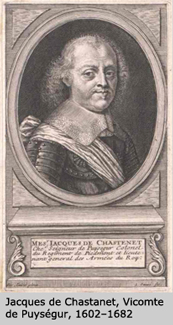The pike was a 12–16 foot long pole with a spear point at the end. While a massed row of pikemen presented a formidable barrier to attackers, the pike had major disadvantages. It hampered rapid movement and required the tallest, strongest soldiers be relegated to a defensive role. By the mid-1600s, muskets had become much lighter. Lighter muskets enabled musketeers to do away with the forked musket-rest and other impediments, which enabled them to maneuver more rapidly on the battlefield. However, their reliance on heavily burdened pikemen limited the advantage which could be gained from the improved musket.
 The first documented military use of the bayonet dates from the 1640s, during the Thirty Years War. French nobleman and general, Jacques de Chastenet, Vicomte de Puységur (1600-1682), wrote in his memoirs of sending troops out armed with bayonets instead of swords in 1647. A life-long soldier from the age of sixteen who fought in over 200 battles, he would become Colonel of the Régiment de Piedmont in 1655; and rise to Lieutenant Général du Armées du Roi (Lieutenant General of the Armies of the King). His memoirs, posthumously published in 1690, describe this 1647 occurrence:
The first documented military use of the bayonet dates from the 1640s, during the Thirty Years War. French nobleman and general, Jacques de Chastenet, Vicomte de Puységur (1600-1682), wrote in his memoirs of sending troops out armed with bayonets instead of swords in 1647. A life-long soldier from the age of sixteen who fought in over 200 battles, he would become Colonel of the Régiment de Piedmont in 1655; and rise to Lieutenant Général du Armées du Roi (Lieutenant General of the Armies of the King). His memoirs, posthumously published in 1690, describe this 1647 occurrence:
"For me, when I was in command at Bergue, in Ypre, Dixmude, and Laquenoc, all the parties that I sent out passed the canals in this fashion. It is true that soldiers did not carry swords, but they had bayonets with handles one foot long, and the blades of the bayonets were as long as the handles, the ends of which were adapted for putting in the barrels of the fusils to defend themselves, when attacked after they had fired." [View an image of this passage from Chastenet's memoirs.]
Written in 1893, Volume I of his five volume Histoire de L'Infanterie en France, Lt. Colonel Victor Belhomme describes a similar use of the bayonet that he claims took place in 1642:
"It was into 1642 that the bayonet was employed for first time at the Army of Flanders. The sword was withdrawn; with the infantrymen sent in party and one gave them in their place a pointed lance of a foot in length, sharp on the two sides, broad of at its base, and adjusted on a wooden sleeve; a foot in length that one inserted in the muzzle of the musket. The infantryman thus had a musket transformed into pike, and could not fire as long as the bayonet was in place." [View an image of this passage from Belhomme's book.]
The similarities in these two accounts are such that they could well be describing the same incident. I tend to lean toward Chastenet's date of 1647, since he was a participant and his account was more contemporaneous to the events described.
Next: 1670s—Official Military Adoption
Return to History of the Bayonet Index
© Ralph E. Cobb 2009 All Rights Reserved



